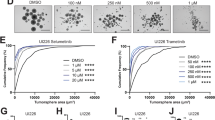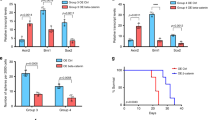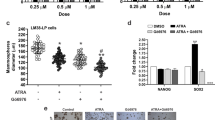Abstract
Wilms tumor is one of the most frequent neoplasias in children. Our previous microarray screening in a large series of Wilms tumors revealed several candidate genes that are deregulated in advanced tumors and are part of the retinoic acid signaling pathway. To investigate whether retinoic acid could be employed as a novel therapeutic agent in these tumors, we treated cultured Wilms tumor cells with different concentrations of all-trans retinoic acid (ATRA) and assessed gene expression changes by real-time RT–PCR as well as microarray analysis. Several genes like RARRES1, RARRES3, CTGF, CKS2, CCNA2, IGFBP3, UBE2C, CCL2 or ITM2B that were previously found to be deregulated in advanced tumors exhibited opposite expression changes after ATRA treatment. In addition to enhanced retinoid signaling, the transforming growth factor-beta (TGFβ) pathway was strongly activated by ATRA treatment of Wilms tumor cells. Both the retinoic acid and the TGFβ pathway mediate inhibition of cell growth. These findings represent the first molecular evidence of a potential benefit from ATRA treatment in Wilms tumors.
This is a preview of subscription content, access via your institution
Access options
Subscribe to this journal
Receive 50 print issues and online access
$259.00 per year
only $5.18 per issue
Buy this article
- Purchase on Springer Link
- Instant access to full article PDF
Prices may be subject to local taxes which are calculated during checkout


Similar content being viewed by others
References
Adamson PC, Reaman G, Finklestein JZ, Feusner J, Berg SL, Blaney SM, O'Brien M, Murphy RF and Balis FM . (1997). J. Clin. Oncol., 15, 3330–3337.
Bahnassy AA, Zekri AR, El-Houssini S, El-Shehaby AM, Mahmoud MR, Abdallah S and El-Serafi M . (2004). BMC Gastroenterol., 4, 22.
Battegay EJ, Raines EW, Seifert RA, Bowen-Pope DF and Ross R . (1990). Cell, 63, 515–524.
Burrow CR . (2000). Pediatr. Nephrol., 14, 240–253.
Casanova B, de la Fuente MT, Garcia-Gila M, Sanz L, Silva A, Garcia-Marco JA and Garcia-Pardo A . (2001). Leukemia, 15, 1521–1526.
Cerignoli F, Guo X, Cardinali B, Rinaldi C, Casaletto J, Frati L, Screpanti I, Gudas LJ, Gulino A, Thiele CJ and Giannini G . (2002). Cancer Res., 62, 1196–1204.
Chang CC, Shih JY, Jeng YM, Su JL, Lin BZ, Chen ST, Chau YP, Yang PC and Kuo ML . (2004). J. Natl. Cancer Inst., 96, 364–375.
Cheung B, Hocker JE, Smith SA, Norris MD, Haber M and Marshall GM . (1998). Oncogene, 17, 751–759.
Choi MC, Jong HS, Kim TY, Song SH, Lee DS, Lee JW, Kim NK and Bang YJ . (2004). Oncogene, 23, 7095–7103.
Farias EF, Arapshian A, Bleiweiss IJ, Waxman S, Zelent A and Mira YLR . (2002). Cell Growth Differ., 13, 335–341.
Fleischer A, Ayllon V, Dumoutier L, Renauld JC and Rebollo A . (2002). Oncogene, 21, 3181–3189.
Freemantle SJ, Kerley JS, Olsen SL, Gross RH and Spinella MJ . (2002). Oncogene, 21, 2880–2889.
Freemantle SJ, Spinella MJ and Dmitrovsky E . (2003). Oncogene, 22, 7305–7315.
Gonzalez AM, Gonzales M, Herron GS, Nagavarapu U, Hopkinson SB, Tsuruta D and Jones JC . (2002). Proc. Natl. Acad. Sci. USA, 99, 16075–16080.
Imai S, Okuno M, Moriwaki H, Muto Y, Murakami K, Shudo K, Suzuki Y and Kojima S . (1997). FEBS Lett., 411, 102–106.
Jin H and Varner J . (2004). Br. J. Cancer, 90, 561–565.
Kansra S, Ewton DZ, Wang J and Friedman E . (2000). Int. J. Cancer, 87, 373–378.
Kastner P, Mark M, Ghyselinck N, Krezel W, Dupe V, Grondona JM and Chambon P . (1997). Development, 124, 313–326.
Kedishvili NY, Chumakova OV, Chetyrkin SV, Belyaeva OV, Lapshina EA, Lin DW, Matsumura M and Nelson PS . (2002). J. Biol. Chem., 277, 28909–28915.
Koliopanos A, Friess H, di Mola FF, Tang WH, Kubulus D, Brigstock D, Zimmermann A and Buchler MW . (2002). World J. Surg., 26, 420–427.
Li P, Gao Y, Ji Z, Zhang X, Xu Q, Li G, Guo Z, Zheng B and Guo X . (2004). J. Pediatr. Surg., 39, 1512–1519.
Lobbert RW, Klemm G, Gruttner HP, Harms D, Winterpacht A and Zabel BU . (1998). Genes Chromosomes Cancer, 21, 347–350.
Pendaries V, Verrecchia F, Michel S and Mauviel A . (2003). Oncogene, 22, 8212–8220.
Petridou E, Skalkidou A, Dessypris N, Moustaki M, Mantzoros C, Spanos E and Trichopoulos D . (2001). Oncology, 60, 252–257.
Reynolds CP, Kane DJ, Einhorn PA, Matthay KK, Crouse VL, Wilbur JR, Shurin SB and Seeger RC . (1991). Prog. Clin. Biol. Res., 366, 203–211.
Reynolds CP, Matthay KK, Villablanca JG and Maurer BJ . (2003). Cancer Lett., 197, 185–192.
Ross SA, McCaffery PJ, Drager UC and De Luca LM . (2000). Physiol. Rev., 80, 1021–1054.
Salmivirta K, Talts JF, Olsson M, Sasaki T, Timpl R and Ekblom P . (2002). Exp. Cell Res., 279, 188–201.
Shyu RY, Jiang SY, Chou JM, Shih YL, Lee MS, Yu JC, Chao PC, Hsu YJ and Jao SW . (2003). Br. J. Cancer, 89, 146–151.
Sriuranpong V, Mutirangura A, Gillespie JW, Patel V, Amornphimoltham P, Molinolo AA, Kerekhanjanarong V, Supanakorn S, Supiyaphun P, Rangdaeng S, Voravud N and Gutkind JS . (2004). Clin. Cancer Res., 10, 4944–4958.
Urbanowicz-Kachnowicz I, Baghdassarian N, Nakache C, Gracia D, Mekki Y, Bryon PA and Ffrench M . (1999). Int. J. Cancer, 82, 98–104.
Xie D, Yin D, Wang HJ, Liu GT, Elashoff R, Black K and Koeffler HP . (2004). Clin. Cancer Res., 10, 2072–2081.
Xie W, Mertens JC, Reiss DJ, Rimm DL, Camp RL, Haffty BG and Reiss M . (2002). Cancer Res., 62, 497–505.
Xie W, Rimm DL, Lin Y, Shih WJ and Reiss M . (2003). Cancer J., 9, 302–312.
Yuan BZ, Zhou X, Durkin ME, Zimonjic DB, Gumundsdottir K, Eyfjord JE, Thorgeirsson SS and Popescu NC . (2003). Oncogene, 22, 445–450.
Zirn B, Wittmann S, Graf N and Gessler M . (2005). Cancer Lett., 220, 115–120.
Acknowledgements
We thank Dr Michael Krause for excellent technical help with microarray hybridizations. This work is part of the PhD thesis of Birgit Zirn. This work was funded by the Graduiertenkolleg 639, the BMBF ‘Kompetenznetz für Pädiatrische Onkologie und Hämatologie’, the Sander Stiftung and parent donations.
Author information
Authors and Affiliations
Corresponding author
Rights and permissions
About this article
Cite this article
Zirn, B., Samans, B., Spangenberg, C. et al. All-trans retinoic acid treatment of Wilms tumor cells reverses expression of genes associated with high risk and relapse in vivo. Oncogene 24, 5246–5251 (2005). https://doi.org/10.1038/sj.onc.1208725
Received:
Revised:
Accepted:
Published:
Issue Date:
DOI: https://doi.org/10.1038/sj.onc.1208725
Keywords
This article is cited by
-
Histone H3K36me2 demethylase KDM2A promotes bladder cancer progression through epigenetically silencing RARRES3
Cell Death & Disease (2022)
-
Tissue expression of retinoic acid receptor alpha and CRABP2 in metastatic nephroblastomas
Diagnostic Pathology (2018)
-
The Retinoid Agonist Tazarotene Promotes Angiogenesis and Wound Healing
Molecular Therapy (2016)
-
Genetic variations in monocyte chemoattractant protein-1 and susceptibility to ovarian cancer
Tumor Biology (2015)
-
Ubiquitin-conjugating enzyme UBE2C: molecular biology, role in tumorigenesis, and potential as a biomarker
Tumor Biology (2012)



